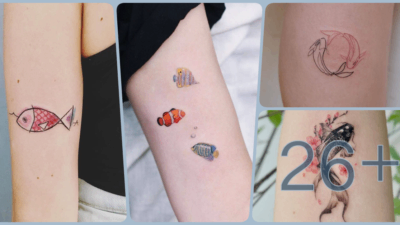A beautiful tattoo is not only a work of art but it also allows you to express yourself. The following article ideassimple will guide you on how to properly care for your tattoo, which will help your tattoo not change color, create beautiful tattoos, and heal wounds quickly.
Tattooing – leaving imprints on the body with beautiful tattoos – has steadily gained acceptance in today’s social society. Beautiful tattoos for men and women come in a wide range of styles and designs. Beautiful and meaningful tattoos, which are most typically found on the wrists, backs, shoulders, and other body parts, can be made to convey the inked person’s lifestyle and personality.

The tattooing procedure is simple: the tattooist will inject ink under the skin with a needle to produce the desired form. If you expose your tattoo to the air or a dusty environment after it has been tattooed, you run the risk of infection and scarring. To get a beautiful tattoo, you must not only rely on the tattooist, you must also play a significant role in cleaning and caring for the tattoo at home. You can inflict a lot of damage to your tattoo if you do not take adequate care of it.
Please learn the steps to properly clean and care for your tattoo!
Basic knowledge for proper tattoo care

Tattoo care right after tattooing
The most crucial consideration is what medicine should be used after tattooing, as your skin is most vulnerable to infection at this time. To care for your tattoo after it’s finished, have the tattooist add an antibiotic ointment or vaseline (petroleum) layer to the tattoo and cover it with a bandage. The bandage will aid in the prevention of invading the skin. Furthermore, the dressing aids in the protection of the tattoo against painful scratches.
- For a few hours, keep the bandage on. It will aid in the absorption of any extra ink or blood from the tattoo.
- You can take the bandage off after a few hours. Hands should be washed with soap and warm water first. Then, using a mild, unscented soap and clean water, carefully wash over the tattoo.
- To dry the tattoo, use a soft towel. After that, dab the tattoo with a small bit of petroleum jelly. You might not need to apply a bandage to keep the tattoo from becoming airtight in the future.
How to take care of the tattoo while the tattoo heals
While you wait for your tattoo to scab over and heal completely, you should:
- The tattoo will be affected if exposed to direct sunlight.
- If you have any other signs or symptoms of infection, see your doctor.
- Sunscreen should not be applied to the tattoo wound until the wound is completely healed
- To reduce bacteria, avoid scratching or bumping the tattoo against nearby items.
- You should avoid wearing tight clothing that rubs on your tattoo, and you should not go swimming or stay in the pool for an extended period of time (you can still use the shower).
Tattoo care steps in 30 days
The size and complexity of a tattoo wound will determine how quickly it heals. Because large tattoos inflict more skin damage than small tattoos, they have a longer period of redness and swelling.

The first day
You should keep the tattoo parlor bandage till you return home. You can take it off after a few hours. Ideally, you should inquire with your tattoo artist about the best time to remove the bandage.
You’ll probably see some fluid seeping out of the tattoo as soon as the bandage is removed. This concoction is made up of blood, plasma, and a smidgeon of tattoo pigment. The skin will turn red and irritated. In addition, the tattoo will make you feel warm when you touch it. Don’t be concerned; this is a relatively common occurrence.
Wash the tattoo with warm water and unscented soap after thoroughly washing your hands.
From day 2 to day 3
The tattoo will start to fade over time. This normally occurs during the healing phase of the skin. The wound will begin to scab at the same time.
Wash your tattoo 1–2 times per day, then moisturize it with a fragrance-free, alcohol-free lotion. It’s possible that some ink will come out when you wash the tattoo. Don’t be concerned this is simply excess ink being squeezed out through the skin’s pores.
From the 4th to the 6th
The redness will decrease with time. Furthermore, you will most likely see some minor scratches on the tattoo. The scabs will not be as thick as typical scales (from scratching your skin), but they will rise above the surface. Avoid peeling off the scabs while caring for your tattoo since they will assist you avoid scarring.
To keep your tattoo clean, wash it 1-2 times per day. After that, apply a moisturizer to the tattoo.
From day 7 to day 14: What medicine should be applied after tattooing?
The tattoo becomes crusty and starts to flake away. The time it takes for a tattoo to peel varies from person to person, but it usually takes between 7 and 14 days. You should not attempt to peel or remove the scabs; instead, let them fall off naturally. If you peel them off on purpose, you risk damaging the young skin behind the tattoo and maybe leaving a scar.
You may notice that your skin is itchy at this time, but you must avoid scratching or rubbing the tattoo. Many of you may be wondering what medicine to use after getting a tattoo. The solution is that you can relieve itching by applying moisturizer a few times per day instead of taking more medication.
If your tattoo is still bloated and red at this point, it’s a symptom that you might have an infection. As soon as possible, see your tattooist or dermatologist.
From the 15th to the 30th day: The tattoo scabs and heals
The majority of the tattoo wound will scab over during this stage of healing, and you should gently remove the scabs.
There may be a few patches of dead skin left, but don’t panic; they’ll fall off on their own. The skin surrounding the tattoo may appear dry and drab. As a result, you should moisturize until your skin is back to normal.
The outer layers of skin will gradually heal in the second or third week after tattooing with proper tattoo maintenance. Furthermore, because the deep skin tissue beneath the skin might take 3–4 months to properly heal, tattoo fading after scabbing may not be a cause for concern. The tattoo will get brighter and more lovely as you desire by the end of the third month.
During tattoo care, if you see any of the following, see a dermatologist for immediate treatment:
- Look for a red lump or line emerging from the tattoo and spreading (for arm and leg tattoos)
- 5-7 days after getting tattooed, the stinging sensation around the tattoo gets worse.
- The tattoo Fever has pus discharge, which is an indication of infection.
You should save the tattoo care and hygiene tips that ideassimple mentioned above to keep the tattoo beautiful and avoid infection. After 15-30 days the tattoo will heal, you will have a tattoo that attracts everyone’s eyes. Hope the above sharing will be useful for you.











